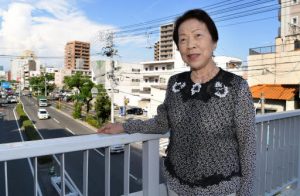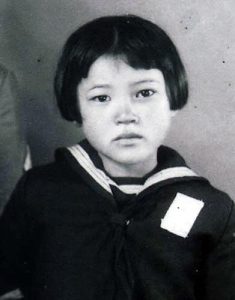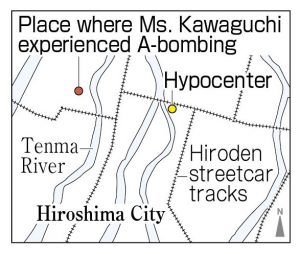Survivors’ Stories: Hiroko Kawaguchi, 81, Hiroshima: Lost her education-minded mother
Sep. 3, 2018
by Sakiko Masuda, Staff Writer
Hiroko Kawaguchi (née Omoya), 81, vividly remembers a promise she made with her mother, who said, “When we die, let’s die together.” At the time, in 1945, she was a third-grader at Tenma National School (now Tenma Elementary School). With the war intensifying, she was evacuated with her sister, among a group of children, to a temple located outside of the city. But it was hard for her to live apart from her parents and she and her sister returned home, despite the possibility that Hiroshima could be attacked at any time.
The atomic bomb, which was dropped on Hiroshima by the United States on August 6, killed her mother and sister. She was eight years old and that day has remained deeply seared in her mind.
Ms. Kawaguchi experienced the atomic bombing near her home in Kamitenmacho (now part of Nishi Ward), about 1.2 kilometers from the hypocenter. She saw the white plume of an enemy aircraft while heading to the river with friends. She sought safety under the eaves of a house in the neighborhood, covering her eyes and ears with her hands. When the building collapsed, she became trapped beneath the wreckage, but she managed to crawl out. She suffered no burns or other injuries.
Ms. Kawaguchi was reunited with her mother, Shizuko, then 33, in front of her house. Shizuko took only a first-aid kit from their home and they fled together. Her mother had gone out to receive rations that morning and she was exposed to the bomb’s flash from behind while on her way home. The back of her body was burned entirely, and she suffered severe wounds to her head from falling roof tiles. Hearing that medical care was available at Koi National School (now Koi Elementary School), she had headed there first.
Later, Ms. Kawaguchi was able to meet her brother, Toshiyuki, now 86, a second-year student at Matsumoto Technical High School (now Setouchi High School) at a vacant lot that was a designated evacuation site. He experienced the bombing while en route to his work site as a mobilized student, then turned back for home. He said that he extinguished the flames approaching their house by using a fire bucket.
Ms. Kawaguchi’s sister, Sumie, then 11, was in the sixth grade at Tenma National School. She went to school that morning and never returned. She had been reluctant to go, but her mother, who wanted Sumie to go on to a girls’ high school, would not let her miss school.
Ms. Kawaguchi then returned home with her mother and brother. Even as the wounded around them fled to the suburbs of the city, her mother wanted to stay, saying that she could not leave the house until Sumie came back.
Her mother became bedridden, and after a while, Ms. Kawaguchi’s aunt came to look after her. The burns on her back were not healing and the wounds became infested with maggots. But her mother did not complain about the pain or itchiness. She said only that she wanted to eat a peach, so Ms. Kawaguchi’s aunt bought one and helped her eat it. She then passed away on September 4. Ms. Kawaguchi thinks that her mother held on as long as she could, hoping to see Sumie return.
Her father, Toshio was killed in the war in China in 1938. He was 32. After her mother died, too, there were only two people left in her family, her brother and herself. After living in a relatives’ shed, they were raised by her aunt and uncle, but she gave up the idea of going to the high school that she wanted to attend.
Ms. Kawaguchi began attending an accounting school at the age of 20 and obtained a certificate in bookkeeping while helping her uncle in his work as a furniture maker. Looking back, she said that this was a happy time. She got married at the age of 22 and now has two children, five grandchildren, and two great-grandchildren. However, she developed thyroid cancer in 1990 and was recognized as having an A-bomb-related disease.
She has contributed her A-bomb account to the Hiroshima National Peace Memorial Hall for the Atomic Bomb Victims. In it, she mentions her mother, who was strict but kind. Her mother, who was strongly focused on her children’s education, worked hard at various jobs, from morning to evening, to provide them with schooling and afterschool activities like calligraphy and ballet.
Ms. Kawaguchi offers peaches for her mother at the family’s Buddhist altar and talks to her when she visits her grave. She said that war must never be condoned, that it hurts innocent children, and she hopes to live a long, healthy life for the sake of her children, grandchildren, and great-grandchildren.
Teenagers’ Impressions
Her mother’s deep love for her family
Ms. Kawaguchi said that her mother was a great person. She was so overwhelmed by the surreal life that she lived in the aftermath of the atomic bombing that didn’t mourn for her mother at that time, but she now visits her mother’s grave, sheds tears, and talks to her. I felt so strongly that nothing can take the place of our love for our family in any era. I also want to show my gratitude to my family and the people around me for all that they’ve done for me. (Yuri Furohashi, 14)
Thankful for the opportunity to receive an education
Ms. Kawaguchi said that she liked to study and learn. Her mother was an “education mama” and had said that the best thing she could leave her children was an education. Ms. Kawaguchi lost her mother in the atomic bombing, then had to give up the idea of going to high school. However, after that, she took up a bookkeeping program and obtained a certificate. She said that if she had been able to study more, her life would have been different. I’m thankful that I live in good circumstances and I want to study hard so that I’ll have no regrets. (Anna Ikeda, 16)
(Originally published on September 3, 2018)
Hiroko Kawaguchi (née Omoya), 81, vividly remembers a promise she made with her mother, who said, “When we die, let’s die together.” At the time, in 1945, she was a third-grader at Tenma National School (now Tenma Elementary School). With the war intensifying, she was evacuated with her sister, among a group of children, to a temple located outside of the city. But it was hard for her to live apart from her parents and she and her sister returned home, despite the possibility that Hiroshima could be attacked at any time.
The atomic bomb, which was dropped on Hiroshima by the United States on August 6, killed her mother and sister. She was eight years old and that day has remained deeply seared in her mind.
Ms. Kawaguchi experienced the atomic bombing near her home in Kamitenmacho (now part of Nishi Ward), about 1.2 kilometers from the hypocenter. She saw the white plume of an enemy aircraft while heading to the river with friends. She sought safety under the eaves of a house in the neighborhood, covering her eyes and ears with her hands. When the building collapsed, she became trapped beneath the wreckage, but she managed to crawl out. She suffered no burns or other injuries.
Ms. Kawaguchi was reunited with her mother, Shizuko, then 33, in front of her house. Shizuko took only a first-aid kit from their home and they fled together. Her mother had gone out to receive rations that morning and she was exposed to the bomb’s flash from behind while on her way home. The back of her body was burned entirely, and she suffered severe wounds to her head from falling roof tiles. Hearing that medical care was available at Koi National School (now Koi Elementary School), she had headed there first.
Later, Ms. Kawaguchi was able to meet her brother, Toshiyuki, now 86, a second-year student at Matsumoto Technical High School (now Setouchi High School) at a vacant lot that was a designated evacuation site. He experienced the bombing while en route to his work site as a mobilized student, then turned back for home. He said that he extinguished the flames approaching their house by using a fire bucket.
Ms. Kawaguchi’s sister, Sumie, then 11, was in the sixth grade at Tenma National School. She went to school that morning and never returned. She had been reluctant to go, but her mother, who wanted Sumie to go on to a girls’ high school, would not let her miss school.
Ms. Kawaguchi then returned home with her mother and brother. Even as the wounded around them fled to the suburbs of the city, her mother wanted to stay, saying that she could not leave the house until Sumie came back.
Her mother became bedridden, and after a while, Ms. Kawaguchi’s aunt came to look after her. The burns on her back were not healing and the wounds became infested with maggots. But her mother did not complain about the pain or itchiness. She said only that she wanted to eat a peach, so Ms. Kawaguchi’s aunt bought one and helped her eat it. She then passed away on September 4. Ms. Kawaguchi thinks that her mother held on as long as she could, hoping to see Sumie return.
Her father, Toshio was killed in the war in China in 1938. He was 32. After her mother died, too, there were only two people left in her family, her brother and herself. After living in a relatives’ shed, they were raised by her aunt and uncle, but she gave up the idea of going to the high school that she wanted to attend.
Ms. Kawaguchi began attending an accounting school at the age of 20 and obtained a certificate in bookkeeping while helping her uncle in his work as a furniture maker. Looking back, she said that this was a happy time. She got married at the age of 22 and now has two children, five grandchildren, and two great-grandchildren. However, she developed thyroid cancer in 1990 and was recognized as having an A-bomb-related disease.
She has contributed her A-bomb account to the Hiroshima National Peace Memorial Hall for the Atomic Bomb Victims. In it, she mentions her mother, who was strict but kind. Her mother, who was strongly focused on her children’s education, worked hard at various jobs, from morning to evening, to provide them with schooling and afterschool activities like calligraphy and ballet.
Ms. Kawaguchi offers peaches for her mother at the family’s Buddhist altar and talks to her when she visits her grave. She said that war must never be condoned, that it hurts innocent children, and she hopes to live a long, healthy life for the sake of her children, grandchildren, and great-grandchildren.
Teenagers’ Impressions
Her mother’s deep love for her family
Ms. Kawaguchi said that her mother was a great person. She was so overwhelmed by the surreal life that she lived in the aftermath of the atomic bombing that didn’t mourn for her mother at that time, but she now visits her mother’s grave, sheds tears, and talks to her. I felt so strongly that nothing can take the place of our love for our family in any era. I also want to show my gratitude to my family and the people around me for all that they’ve done for me. (Yuri Furohashi, 14)
Thankful for the opportunity to receive an education
Ms. Kawaguchi said that she liked to study and learn. Her mother was an “education mama” and had said that the best thing she could leave her children was an education. Ms. Kawaguchi lost her mother in the atomic bombing, then had to give up the idea of going to high school. However, after that, she took up a bookkeeping program and obtained a certificate. She said that if she had been able to study more, her life would have been different. I’m thankful that I live in good circumstances and I want to study hard so that I’ll have no regrets. (Anna Ikeda, 16)
(Originally published on September 3, 2018)










